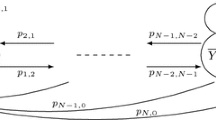Abstract
We consider the forecasting problem for components of a bank’s credit portfolio, in particular, for the share of non-performing loans. We assume that changes in the portfolio are described by a Markov random process with discrete time and finite number of states. By the state of a loan we mean that it belongs to a certain group of loans with respect to the existence and duration of arrears. We assume that the matrix of transitional probabilities is not known exactly, and information about it is collected during the system’s operation.
Similar content being viewed by others
References
Markov, A.A., Extension of the Law of Large Numbers to Dependent Variables, Izv. Fiz.-Mat. Obshch. Kazan. Univ., 1906, ser. 2, vol. 15, pp. 135–156.
Jones, M.T., Estimating Markov Transition Matrices Using Proportions Data: An Application to Credit Risk, IMF Working Paper, 2005, WP-05-219.
Thyagarajan, V. and Saiful, M., Retail Banking Loan Portfolio Equilibrium Mix: A Markov Chain Model Analysis, Am. J. Appl. Sci., 2005, vol. 2(1), pp. 410–419.
Zhuravel’, Yu.Yu., Modern Problems in Reserving a Retail Credit Portfolio, Bankovs. Riteil, 2007, no. 4, pp. 21–36.
Timofeev, N.A., Mathematical Model of Vintage Analysis for a Bank’s Credit Portfolio, Vestn. UrGUPS, 2011, vol. 9, no. 1, pp. 86–92.
Lee, T.C., Judge, G.G., and Zellner, A., Estimating the Parameters of the Markov Probability Model from Aggregate Time Series Data, Amsterdam: North Holland, 1970.
Mezhdunarodnaya konvergentsiya izmereniya kapitala i standartov kapitala. Utochnennye ramochnye podkhody (International Convergence in Measuring Capital and Capital Standards. Specified Framework Approaches), Basel Banking Overseer Committee, Moscow: Bank Mezhd. Raschetov, 2004.
Kan, Yu.S. and Kibzun, A.I., Zadachi stokhasticheskogo programmirovaniya s veroyatnostnymi kriteriyami (Stochastic Programming Problems with Probabilistic Criteria), Moscow: Fizmatlit, 2009.
Varaiya, P. and Kurzhanski, A.B., Ellipsoidal Methods for Dynamics and Control. Part I, J. Math. Sci., 2006, vol. 139(5), pp. 6863–6901.
Matasov, A.I., Vvedenie v teoriyu garantiruyushchego otsenivaniya (Introduction to Guaranteeing Estimation Theory), Moscow: Mosk. Aviats. Inst., 1999.
Gusev, M.I., On External Estimates on Reachability Sets for Nonlinear Controllable Systems, Tr. Inst. Mat. Mekh. UrO RAN, 2011, vol. 17, no. 1, pp. 60–69.
Kostousova, E.K., On External Polyhedral Estimates on Reachability Sets for Systems with Bilinear Uncertainty, Prikl. Mat. Mekh., 2002, vol. 66, no. 4, pp. 559–571.
Vishnyakov, B.V and Kibzun, A.I., Application of the Bootstrap Method for Estimation of the Quantile Function, Autom. Remote Control, 2007, vol. 68, no. 11, pp. 1931–1944.
Timofeeva, G.A., Optimal and Suboptimal Solutions to Stochastically Uncertain Problems of Quantile Optimization, Autom. Remote Control, 2007, vol. 68, no. 7, pp. 1145–1157.
Kalbfleisch, J.D. and Lawless, J.F., Least-Squares Estimation of Transition Probabilities From Aggregate Data, Can. J. Stat., 1984, vol. 12(3), pp. 169–182.
MacRae, E.Ch., Estimation of Time-Varying Markov Processes with Aggregate Data, Econometrica, 1977, vol. 45(1), pp. 183–198.
Anderson, T.W. and Goodman, L.A., Statistical Inference about Markov Chains, Ann. Math. Stat., 1957, vol. 28, pp. 89–110.
Venttsel’, E.S. and Ovcharov, A.A., Teoriya sluchainykh protsessov i ee inzhenernye prilozheniya (Theory of Random Processes and Its Engineering Applications), Moscow: Nauka, 1991.
Bellman, R.E., Introduction to Matrix Analysis, New York: McGraw-Hill, 1960. Translated under the title Vvedenie v teoriyu matrits, Moscow: Nauka, 1968.
Fidler, M., Nedoma, I., Ramik, Ya., Ron, I., et al., Zadachi lineinoi optimizatsii s netochnymi dannymi (Linear Optimization Problems with Imprecise Data), Moscow: NITs Regulyarnaya i Khaoticheskaya Dinamika, 2008.
Author information
Authors and Affiliations
Additional information
Original Russian Text © G.A. Timofeeva, N.A. Timofeev, 2012, published in Avtomatika i Telemekhanika, 2012, No. 4, pp. 47–65.
Rights and permissions
About this article
Cite this article
Timofeeva, G.A., Timofeev, N.A. Forecasting credit portfolio components with a Markov chain model. Autom Remote Control 73, 637–651 (2012). https://doi.org/10.1134/S0005117912040042
Received:
Published:
Issue Date:
DOI: https://doi.org/10.1134/S0005117912040042




